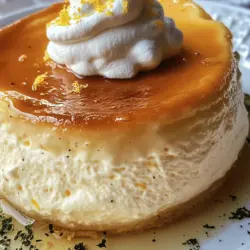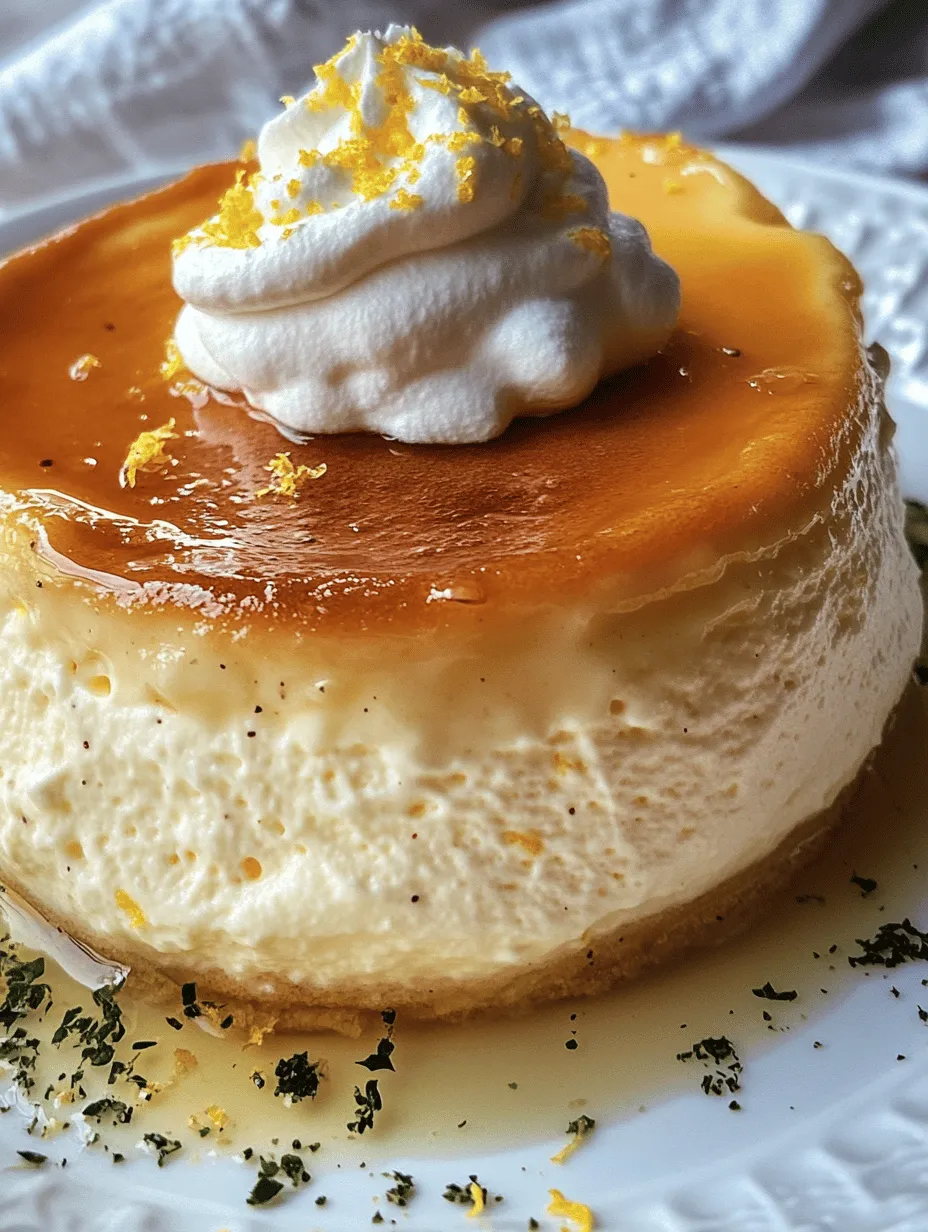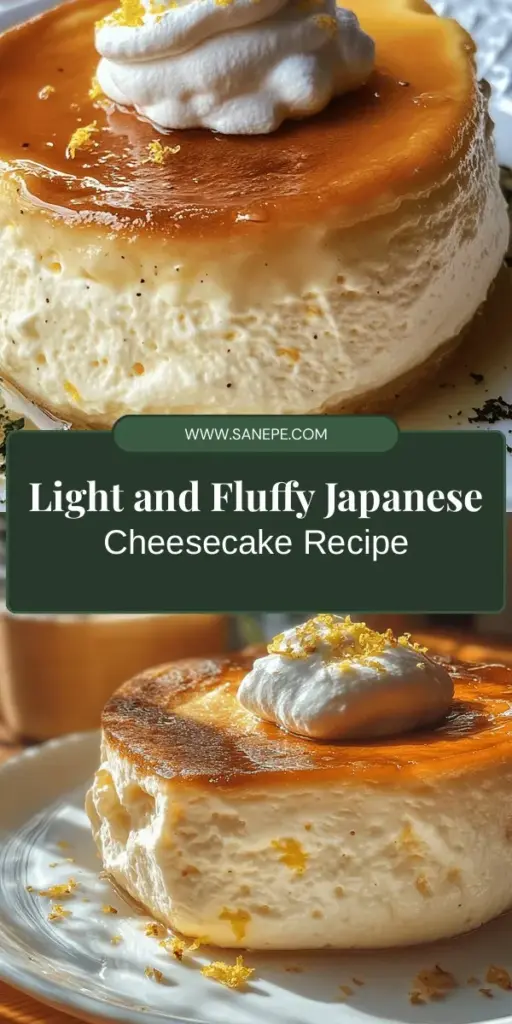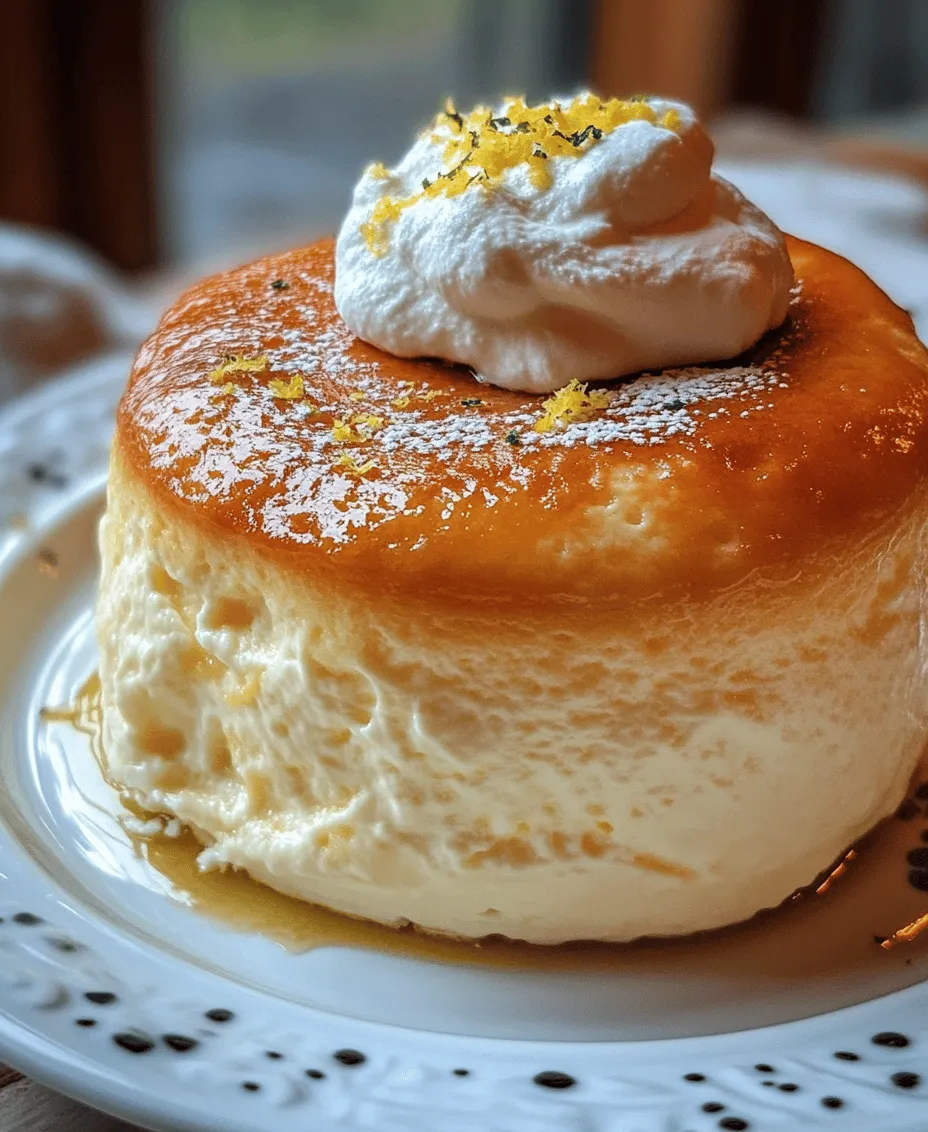Introduction
Japanese cheesecake, often referred to as “soufflé cheesecake,” has taken the culinary world by storm with its light, airy texture and delicate flavor. Originating from Japan, this delightful dessert has become a favorite among dessert enthusiasts globally. Unlike traditional cheesecakes, which are denser and creamier, Japanese cheesecake offers an ethereal quality that melts in your mouth, making it a unique treat for any occasion.
What sets Japanese cheesecake apart is its unique preparation method and ingredient combination. It incorporates whipped egg whites, which lend the cake its signature fluffiness, while a blend of cream cheese, eggs, and sugar creates a subtly sweet flavor profile. This cake is not overly rich, making it an ideal dessert for those who prefer a lighter option compared to traditional cheesecakes.
In this article, we’ll guide you through everything you need to know to create your own Fluffy Japanese Cheesecake. We’ll delve into its historical background, cultural significance, and the essential ingredients that contribute to its incredible texture and flavor. Finally, we will provide step-by-step instructions to ensure your baking experience is seamless and enjoyable.
Understanding Japanese Cheese Cake
Japanese cheesecake has a rich history that reflects Japan’s culinary evolution. The origins of this cake can be traced back to the introduction of Western-style cheesecakes during the Meiji era in the late 19th century. This period marked a significant cultural exchange between Japan and the West, leading to the adaptation of various Western recipes, including cheesecakes. Over time, Japanese bakers began to experiment with these recipes, ultimately creating a lighter version that would resonate with the Japanese palate.
Culturally significant in Japan, this dessert often appears in tea houses and bakeries, embodying the nation’s appreciation for delicate flavors and textures. The rise of Japanese cheesecake on the global stage can be attributed to social media and the increasing interest in Japanese cuisine. Influencers and food bloggers have showcased its unique appearance and texture, sparking curiosity and encouraging home bakers to try their hand at this delightful treat.
The texture of Japanese cheesecake is unlike any other; it’s light, fluffy, and has a cloud-like quality. While traditional cheesecakes tend to be rich and dense, the Japanese version offers a milder sweetness, making it a perfect companion for afternoon tea or as a light dessert after a meal. The flavor profile is a harmonious blend of creamy cheese, a hint of vanilla, and a subtle tang from the lemon zest. Each bite is a delightful experience that leaves you wanting more.
Ingredients Breakdown
To create the perfect Fluffy Japanese Cheesecake, understanding each ingredient’s role is crucial. Below is a detailed breakdown of the essential components that will contribute to the cake’s unique texture and flavor.
1. Cream Cheese: The star ingredient of any cheesecake, cream cheese provides the rich, creamy base that defines the dessert. It’s essential to use softened cream cheese to ensure it blends smoothly into the batter, creating a uniform texture. Avoiding lumps is key to achieving that creamy consistency.
2. Unsalted Butter: Using unsalted butter allows you to control the salt content in your recipe. This is important for balancing flavors, as the cake shouldn’t be overly salty. The butter also contributes to the cake’s moisture and richness.
3. Milk: The type of milk you use can affect the cake’s final texture. Whole milk is often preferred due to its fat content, which adds richness. However, you can also substitute with low-fat milk or even non-dairy alternatives, depending on your dietary preferences.
4. Flour and Cornstarch: These two ingredients work together to provide structure to the cake. All-purpose flour gives the cake its body, while cornstarch lightens the mixture, ensuring a fluffy texture. The combination of both helps create that melt-in-your-mouth sensation.
5. Eggs: Eggs play a crucial role in the cheesecake’s structure and fluffiness. It’s important to separate the yolks from the whites. The yolks add richness and flavor, while the whipped egg whites provide the necessary lift and airy texture that defines Japanese cheesecake.
6. Sugar: Sugar not only sweetens the cake but also affects its texture. When whipped with egg whites, sugar helps stabilize the meringue, contributing to the cake’s lightness. It’s essential to use granulated sugar for the best results.
7. Vanilla Extract and Lemon Zest: These ingredients enhance the cake’s flavor profile. Vanilla extract offers a warm, sweet note, while lemon zest adds a refreshing brightness that cuts through the richness of the cream cheese.
8. Salt: A pinch of salt is crucial in any dessert as it balances sweetness and enhances flavor. It helps to elevate the overall taste of the cheesecake, making the flavors pop.
Step-by-Step Instructions
Before diving into the preparations, it’s important to set up your baking environment for success. Here are the initial steps to prepare for baking your Fluffy Japanese Cheesecake:
1. Preheat the Oven: Begin by preheating your oven to 320°F (160°C). A consistent temperature is key to baking the cheesecake evenly, ensuring that it rises properly without cracking.
2. Prepare the Cake Pan: Choose a 9-inch round cake pan with a removable bottom for easy release. Line the bottom with parchment paper and grease the sides lightly with butter. This will help prevent the cake from sticking, ensuring a smooth release once it’s cooled.
3. Create a Water Bath: Japanese cheesecake is traditionally baked in a water bath to maintain moisture and prevent the cake from drying out. To do this, wrap the bottom of the cake pan with aluminum foil to avoid leaks, then place the pan in a larger roasting pan. Fill the outer pan with hot water until it reaches halfway up the sides of the cake pan. This gentle baking method helps achieve the desired fluffy texture.
4. Prepare the Batter: In a mixing bowl, combine the softened cream cheese and unsalted butter. Beat together until smooth and creamy, ensuring there are no lumps. This step is crucial for achieving a silky batter.
5. Add the Wet Ingredients: Gradually add the milk, vanilla extract, and lemon zest to the cream cheese mixture, mixing until well combined. The batter should be smooth and homogeneous.
6. Incorporate the Dry Ingredients: Sift together the flour and cornstarch, then gently fold them into the cream cheese mixture. Be careful not to overmix, as this can lead to a denser cake.
7. Whip the Egg Whites: In a separate bowl, beat the egg whites until frothy. Gradually add sugar while continuing to whip until stiff peaks form. This will create a light and airy meringue, which is essential for the cake’s fluffiness.
8. Combine the Mixtures: Gently fold the whipped egg whites into the cream cheese batter in three additions. This technique helps maintain the airiness of the egg whites, ensuring the cake remains light and fluffy.
9. Transfer to the Pan: Pour the batter into the prepared cake pan, smoothing the top with a spatula. Tap the pan gently on the counter to release any trapped air bubbles.
10. Bake the Cheesecake: Place the baking setup in the preheated oven. Bake for approximately 60-70 minutes, or until the top is golden brown and a toothpick inserted into the center comes out clean. The cake will puff up beautifully during baking.
By following these initial steps, you’ll be well on your way to creating a Fluffy Japanese Cheesecake that’s sure to impress your family and friends. Stay tuned for more detailed instructions and tips to perfect this delightful dessert!
Mixing the Batter
To achieve a fluffy Japanese cheesecake, the mixing process is critical. Begin by combining your dry ingredients, such as cake flour, cornstarch, and baking powder, in a separate bowl. Sifting these ingredients together not only eliminates lumps but also aerates the flour, contributing to a lighter batter.
Incorporate your wet ingredients, including egg yolks, milk, and melted cream cheese, into the dry mixture. When combining these, use a whisk or a spatula to mix gently. The key is to avoid overmixing, as this can develop gluten in the flour, resulting in a denser texture. Aim for a smooth, lump-free batter. If you notice small lumps of cream cheese, a quick blitz with an immersion blender can help achieve a silky consistency without overworking the mixture.
Whipping Egg Whites
Whipping egg whites is where the magic happens in Japanese cheesecake. The science behind achieving stiff peaks lies in the incorporation of air into the egg whites. Begin with clean, dry mixing bowls and beaters, as any fat or moisture can hinder the process.
Start whipping the egg whites on a low speed until they become frothy. Gradually add in a pinch of cream of tartar or a splash of lemon juice to stabilize the egg whites, which helps them maintain their volume. Once they begin to thicken, gradually introduce sugar, increasing the mixer speed to medium-high. Whip until you achieve stiff peaks, which means the egg whites stand upright when the beaters are removed.
Be cautious not to overwhip; if the egg whites start to look dry or grainy, they will not fold into the batter properly. If you suspect your egg whites aren’t stiff enough, simply continue whipping a little longer until they reach the desired consistency.
Folding Techniques
Folding is an essential technique that ensures your whipped egg whites are gently incorporated into the batter without deflating them. To do this, take a small portion of the whipped egg whites and add it to the batter, stirring gently to lighten the mixture.
Using a rubber spatula, scoop from the bottom of the bowl and fold over the top, rotating the bowl as you go. Repeat this process, adding more egg whites gradually, until the batter is evenly mixed. The key is to be gentle and avoid vigorous stirring, which could result in a loss of volume and the signature fluffiness of the cake.
Baking Process
Baking Japanese cheesecake requires the water bath technique, which helps regulate temperature and prevents the cake from drying out. Preheat your oven to 320°F (160°C) and prepare a large baking pan by placing a damp towel in the bottom. Place the cheesecake pan inside the larger pan, then fill the outer pan with hot water until it reaches halfway up the sides of the cheesecake pan.
This method creates a moist environment that promotes even baking and prevents the cake from cracking. Bake the cheesecake for about 60-70 minutes. You’ll know it’s done when the top is golden and slightly bouncy to the touch. A toothpick inserted should come out clean, though it’s normal for the center to jiggle slightly as it will continue to set while cooling.
Cooling and Serving
Once baked, it’s crucial to cool the cheesecake slowly to enhance its flavor and texture. Remove the cake from the oven but leave it in the water bath for about 10 minutes before transferring it to a wire rack. This gradual cooling process helps prevent cracks from forming.
After removing it from the water bath, let it cool at room temperature for at least an hour. Then, refrigerate the cheesecake for a minimum of four hours or overnight for the best results. This resting period allows the flavors to develop and the texture to set.
When ready to serve, run a knife around the edges of the pan to help release the cake. Invert it onto a serving plate or leave it in the pan for a more rustic presentation.
Common Mistakes and How to Avoid Them
Overmixing the Batter: Overmixing can lead to a dense cheesecake. To prevent this, mix just until the ingredients are combined and smooth.
Underwhipping Egg Whites: If your egg whites are underwhipped, the cake may not rise as expected. Signs include a lack of volume and soft peaks that droop. If this happens, return to your mixer and whip until stiff peaks form.
Baking Issues: To avoid cracking, keep an eye on your cheesecake while baking. If it puffs up too high or looks dry, it may be overbaked. Use the toothpick test and remove the cheesecake when it is slightly jiggly in the center.
Techniques for Perfect Cooling and Storage: Allow the cheesecake to cool slowly to avoid cracks. For storage, keep it in an airtight container in the refrigerator, and consume it within three days for optimal freshness.
Serving Suggestions
When it comes to garnishing your fluffy Japanese cheesecake, simplicity is key. A dusting of powdered sugar adds a touch of sweetness without overpowering the delicate flavor. Fresh fruits like strawberries, blueberries, or a medley of seasonal berries provide a refreshing contrast. For a decadent touch, consider drizzling a homemade fruit sauce or a rich chocolate ganache over the top.
Beverage pairings can elevate your cheesecake experience. A cup of fragrant green tea or a light herbal tea complements the cheesecake beautifully. For a more indulgent pairing, consider serving it with a glass of dessert wine or a creamy cappuccino.
For creative serving styles, consider slicing the cheesecake into individual servings and plating them with a dollop of whipped cream and a sprinkle of citrus zest. Alternatively, layer the cheesecake with crushed graham crackers and fresh fruit in a glass for a delightful parfait presentation.
Health and Nutritional Aspects
In terms of nutrition, a slice of fluffy Japanese cheesecake typically contains about 200-250 calories, depending on portion size and specific ingredients used. The cheesecake provides a good source of protein from the eggs and cream cheese, while offering some carbohydrates from the cake flour.
For those with dietary restrictions, modifications can be made. Substitute gluten-free flour for traditional cake flour to create a gluten-free version. You can also experiment with reducing sugar or using sugar alternatives like stevia to achieve a lower-sugar version without sacrificing texture.
It’s important to enjoy this dessert in moderation. While it’s a delightful treat, balancing indulgence with mindful eating promotes a healthier relationship with food.
Conclusion
Making and enjoying fluffy Japanese cheesecake is a rewarding experience that combines the art of baking with the joy of indulging in a light, airy dessert. The process may seem intricate, but with the right techniques and attention to detail, anyone can master this delightful recipe.
We encourage you to try your hand at creating this light and fluffy dessert. Share your experiences and any variations you may have tried. The versatility and charm of fluffy Japanese cheesecake make it a wonderful addition to any dessert repertoire. Whether served at a special occasion or as a sweet treat for yourself, this cheesecake is sure to impress and delight.



